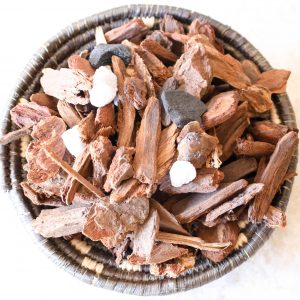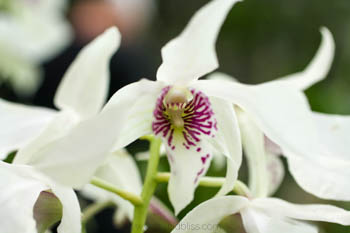
I’ve compiled a list of 24 beautiful dendrobium orchids that are easy to grow, so you don’t have to waste your time on money on dendrobiums that can be hard to grow. If you’re wondering which dendrobiums to grow, put these at the top of your list.
Dendrobium kingianum | Dendrobium Phalaenanthe/Phalaenopsis | Dendrobium Latouria | Dendrobium Spatulata / Antelope |
|
|
|
|
The easiest types of dendrobiums include kingianum, phalaenopsis, latouria (warm-growing), and antelope. Read on for complete light and temperature requirements, watering and fertilizing instructions, and potting information. Dendrobium orchids are not hard to grow if you follow these guidelines.
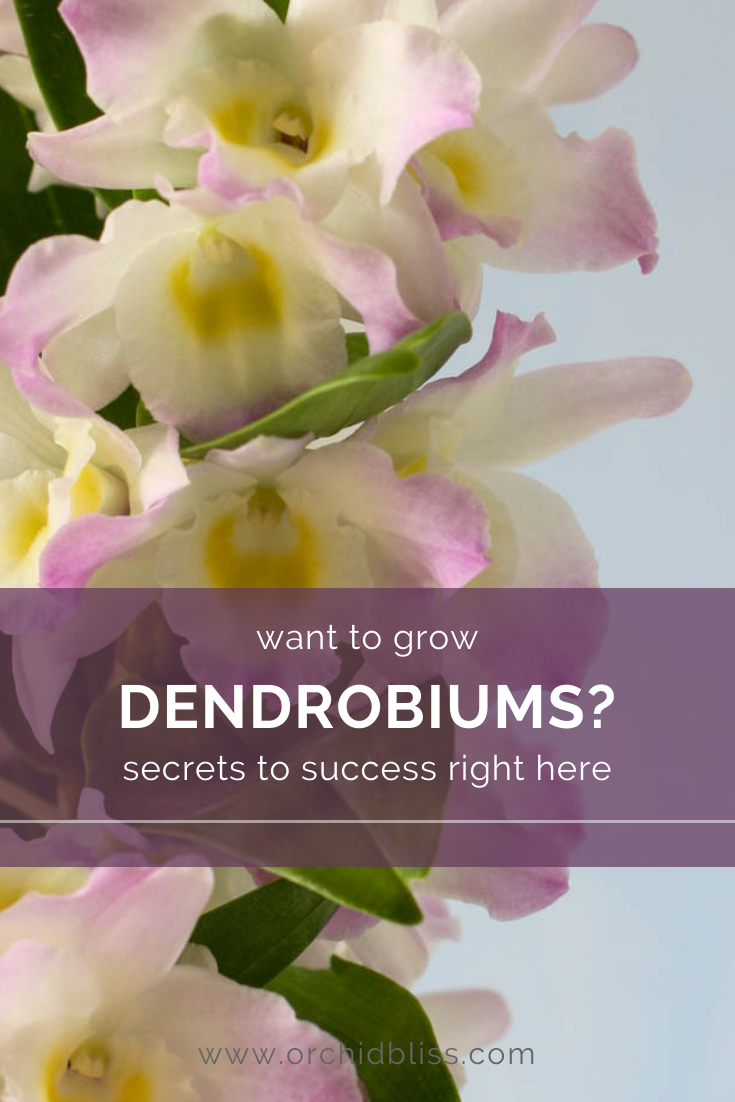
Some of the links on this page may be affiliate links. Click here to learn more.
1. Kingianum
What better Dendrobiums to start with than orchids from Australia? Kingianum orchids are among the easiest of Dendrobium orchids to grow. And these orchids have a lovely fragrance.
Light
Provide bright light year-round – in other words, cattleya light. Give these orchids as much light as possible without burning the leaves.
Temperature
77° F / 25° C in summer, not below 41° F / 5° C in winter
Watering and Fertilizing
During spring and summer, water when potting media is almost dry. In winter, reduce water – but do not let canes shrivel. Use a balanced fertilizer once or twice a month when new roots and leaves are growing.
Potting
Pot kingianums every 1 or two years with a Monterey pine bark potting mix. Add small stones like river pebbles to the potting mix to improve drainage. Choose a pot small enough to allow for 1-2 years’ growth. Re-pot once flowering has finished. CLICK HERE for my favorite bark-based potting mix by rePotme.
Keikis
General overwatering and over-fertilizing in winter may result in keikis – baby plantlets. After the keikis begin to grow roots, they may be removed from the mother plant and potted up.
Recommended Dendrobium Kingianum Orchids
- Den. Kingianum ‘Inferno’
- Den. Kingianum ‘Betty’
- Den. Kingianum ‘Jewel’
- Den. Kingianum ‘ Sparkles’
- Den. Kingianum ‘Katherine Banks’
- Den. Kingianum ‘Little Beauty’
2. Phalaenanthe/Phalaenopsis
Phalaenanthe are sometimes called phalaenopsis dendrobiums because the orchids’ flowers look similar to Phalaenopsis orchids, but they’re Dendrobiums within a category or section called Phalaenanthe. These orchids are among the easiest dendrobiums to care for.
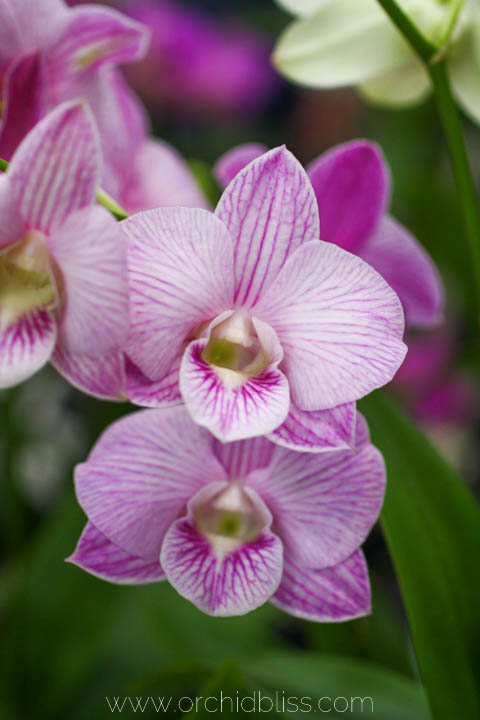
Light
Provide bright light year-round – cattleya light. To maximize blooming give these orchids lots of light. If your location allows it, summer them orchids outdoors. If outdoors is not a possibility, try a west or south-facing window.
Temperature
Phalaenanthe-type dendrobium orchids thrive in a home environment. That’s really good news for orchid growers because the temperature is the hardest part to control when growing orchids. That’s why choosing orchids that grow within temperature ranges that can easily be accommodated is vital. The maximum daytime temperature for this orchid is 85° F / 30° C with minimum temperatures of 58° F / 14° C at night.
Granted 85° F / 30° C is a little toasty for indoor comfort, but that’s not a problem. Just keep in mind that warmer summer temperatures will encourage faster growth and more flowers. Of course, if summering outdoors is an option, these warmer temperatures may be more easily obtained.
Watering and Fertilizing
Like other types of Dendrobiums, these Phalaenanth-type dendrobiums need to dry out between watering. When you do water, water thoroughly, then allow the potting media to dry out. Nothing will kill a dendrobium more quickly than overwatering.
Happily, there are a few things you can do to prevent overwatering.
- Pot size matters. Choose a small pot that will hold the roots and allow for a couple of years’ growth. Larger pots will stay wet in the center longer. A smaller pot is better because it will dry out more quickly.
- Pot material matters. Plastic pots stay wet longer. Terracotta dries out more quickly.
- Weight matters. After watering, pick up your pot and feel how heavy it feels. A few days later pick up the pot again. I will feel lighter.
- Time matters. If growing your dens indoors, start by watering your dendrobium phalaenopsis orchids once a week and see how that goes. If you grow your dens outdoors, the watering frequency will be determined by your climate.
- Pseudobulbs matter. The canes that phalaenopsis orchids grow on are also called pseudobulbs. If the pseudobulbs are firm and plump – that’s good. If they start to shrivel, that’s a sign of dehydration, and you should increase watering frequency.
Use a balanced fertilizer at half strength throughout the year 2-3 times a month. On the weeks that you do not use fertilizer, flush the potting media of fertilizer salts.
Potting
Pot Dendrobium phalaenopsis every 2-3 years after it has finished blooming and new roots are visible.
Signs your den. is ready to be re-potted:
- The potting media is beginning to break down.
- The rhizome is growing over the edge of the pot. You may see new roots budding out over the edge.
- The orchid is rootbound.
The most commonly used potting mix for dendrobiums is a Monterey Pine bark mix. CLICK HERE for my favorite bark-based potting mix by rePotme.
TIP: Always use sterilized cutting tools when potting orchids to prevent the spread of disease
Recommended Dendrobium Phalanthe/Phalaenopsis Orchids
- Den. Sonia
- Den. Classic White ‘Memoria Yukie Nakano’
- Den Agena Peach ‘Peachy’
- Den. Burana
- Den. Agena Sem
- Den. Enobi
Dendrobium kingianum and Phalaenanthe are considered the easiest of all Dendrobiums to grow. If you aren’t sure if a Dendrobium you are considering buying is either a kingianum or Phalaenanth type dendrobium, simply ask the seller.
3. Latouria (warm growing)
If you’ve found success growing kingianum and Phalaenanthe, you may be ready to move on to Latouria-type Dendrobiums. My personal favorite is the hybrid, Roy Tokunaga.
Be aware that some Latouria are cool-growers. Be sure to select a warm-grower, as warm grower temperatures are much easier for most home growers to provide. Being able to deliver proper temperatures is important if you want to rebloom your orchids.
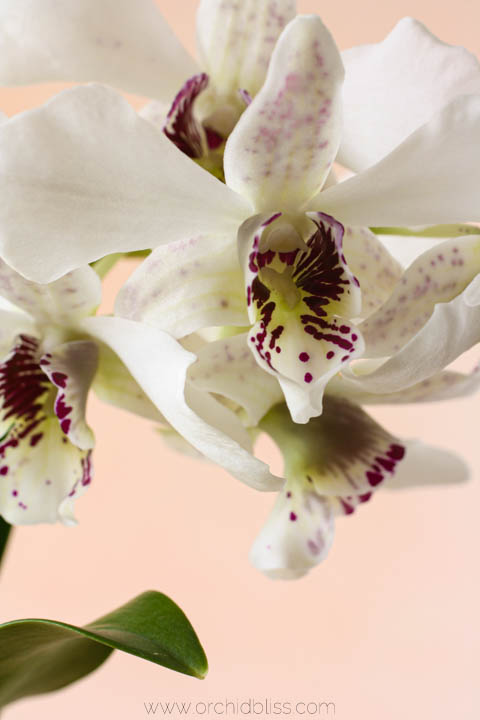
Light
Provide bright light year-round – in other words, cattleya light. Give these orchids as much light as possible without burning the leaves.
Temperature
65° – 90° F / 18-32 C during the day and 60° F / 15.5° C at night. Allow for a slight drop in temperature for a winter rest.
TIP: Some dendrobium orchids in the Latouria section are cool-growing, so be sure to ask the seller for warm-growing Latourias.
Watering and Fertilizing
Water copiously, then allow the orchid roots to almost dry before watering again. During the winter, reduce watering frequency by 20%.
Use a balanced fertilizer at half strength throughout the year 2-3 times a month. On the weeks that you do not use fertilizer, flush the potting media of fertilizer salts.
Potting
These tall, arching orchids like to be underpotted and can be top-heavy. Nest an inner culture pot in a heavy clay pot to add stability. Use a free-draining potting mix to allow roots to dry between watering. CLICK HERE for my favorite bark-based potting mix by rePotme.
Recommended Dendrobium Latouria Orchids
- Den. Roy Tokunaga
- Den. Little Green Apples
- Den. Little Atro
- Den. macrophyllum
- Den. Convolutum
- Den. Johnsoniae
4. Spatulata – Antelope Type
Spatalata is also called antelope-type dendrobiums due to their tall, twisting petals reminiscent of antelope horns. These orchids are similar in care to the Latourias. Keep in mind that there are many Spatulatas that can grow very large. So, purchase a compact variety unless you have a lot of space. Look for Spatulata hybrids called semi-antelope types. These tend to be smaller but still have beautiful twisting petals and abundant long-lasting flowers.
Light
Provide bright light year-round.
Temperature
Nighttime temperatures, 60- 65° F / 15.5° – 18° C, and daytime temperatures between 75°-90° F / 24°-32° C. These are warm-growing orchids without a winter rest or temperature drop.
Watering and Fertilizing
Water copiously, then allow the orchid roots to almost dry before watering again. During the winter, reduce watering frequency as it takes longer for the potting media to dry.
Use a balanced fertilizer, diluting by 50%. As these are heavy feeders, fertilize 3 out of 4 weeks. Flush potting media of salts on the 4th week.
Potting
These dendrobiums do not like to be potted, so use a Monterey pine bark mixed with an inorganic material that won’t break down such as LECA (also called clay pellet or Hydroton) pellets or lava rock . The inorganic component will help keep the bark from compacting, providing the roots with oxygen and will help to delay potting. CLICK HERE for my favorite bark-based potting mix by rePotme.
Plan to pot every 3 years. When placing the orchid in the potting mix, prevent rot by using care not to plant too deeply.
Choose a small pot for the size of the orchid. This will help the potting media dry out faster and encourage overall plant growth and more flowers.
Recommended Dendrobium Spatulata/Antelope Orchids
- Den. Thai Pixie
- Den. Taurinum (large plant)
- Den. Andy Cheah
- Den. Blue Twinkle
- Den. Tangerinum
- Den. Penang’ Little Magic’
Dendrobium Orchid Culture Notes
Here are just a few tips that relate to all dendrobiums that will help your orchids to flourish.
Air Movement
First, regardless of dendrobium, all orchids need plenty of air movement to prevent disease. A small fan, set to low, pointed away from the orchids, is all you need. Click Here to find out why air movement prevents disease and other benefits of airflow.
Humidity
Next, just as all orchids need airflow, they also need humidity. If you live in a dry climate, invest in a humidifier. Or, you can use a humidity tray. Just fill the tray with pebbles and add water. Be sure that the orchids don’t actually sit in the water. A humidity tray will create a microclimate for your orchids and elevate the humidity surrounding the plants. Click Here to learn more about why orchids need water in the air – humidity.
Light
Lastly, if you find that your home doesn’t provide enough light for your orchids, providing artificial light will help your orchids get the light they need to convert light into energy for lots of flowers. Click Here to learn more about how to give your orchids more light.
Dendrobium Care Card
For easy-reference care information on Dendrobium orchids, CLICK HERE.

